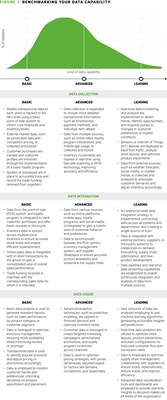
• Weekly transactional data at
each store is tracked to the
SKU level using a basic
point-of-sale system to
inform core financials and
inventory levels
• External market data, such
as syndicated data and
competitor pricing, is
collected and stored
• Customer purchases are
tracked and customer
profiles are informed
through the implementation
of a basic loyalty program
• System or processes are in
place to accurately track and
record the trade funding
received from suppliers
• Data collection is expanded
to include more detailed
transactional information,
such as timestamps,
payment methods, and
individual item details
• Data from multiple sources,
such as online sales, loyalty
program interactions, and
mobile app usage, is
collected and stored
• Inventory movements are
tracked in real-time using
barcode scanning or RFID
technology, improving
accuracy and efficiency
• Real-time data monitoring
and analysis are
implemented to detect
trends, identify opportunities,
and respond quickly to
changes in customer
preferences or market
conditions
• Sensors or Internet of Things
(IoT) devices are deployed to
track foot traffic, analyze
store layouts, and optimize
product placements
• Data from external sources,
such as weather forecasts,
social media, or market
trends, is collected and
analyzed to anticipate
customer demands and
adjust inventory accordingly
• Data from the point-of-sale
(POS) system and loyalty
program is integrated to track
customer purchases and offer
basic rewards or discounts
• Inventory data is synced
across multiple store
locations to ensure accurate
stock levels and enable
efficient replenishment
• Online sales data is integrated
with in-store transactions by
the grocer to gain a
consolidated view of overall
sales performance
• Trade funding received is
matched with the
corresponding sales data for
which it is intended
• Data from various sources,
such as online platforms,
mobile apps, loyalty
programs, and social media,
is integrated to gain a holistic
view of customer behavior
and preferences
• Data is synchronized
between the POS system,
inventory management
system, and supplier
databases to ensure accurate
product availability and
streamline the supply chain
• An enterprise-wide data
integration strategy is
implemented, connecting
data across all systems and
departments, and creating a
single source of truth
• Data is integrated with
external partners, suppliers, or
third-party systems to
collaborate on demand
forecasting, supply chain
optimization, and new
product development
• Data pipelines and real-time
data streaming capabilities
are established to enable
continuous integration and
analysis of data from
multiple sources
• Basic data analysis is used to
generate standard reports,
such as sales performance
by product category or
customer segment
• Data is leveraged to optimize
inventory management,
ensuring stock availability
while minimizing excess
or shortage
• Transactional data is used
to identify popular products
and adjust pricing or
promotions accordingly
• Data is employed to monitor
customer trends and
preferences, informing
decisions on product
assortment and placement
• Advanced analytics
techniques, such as predictive
modeling, are applied to
forecast demand and
optimize inventory levels
• Customer data is leveraged to
create targeted marketing
campaigns, personalized
promotions, and loyalty
program incentives
across channels
• Data is used to optimize
pricing strategies, with prices
dynamically adjusted based
on factors like demand,
competition, and seasonality
• Vast amounts of data are
analyzed employing AI and
machine learning algorithms,
generating actionable insights
and predictions
• Real-time data analytics are
utilized to optimize store
layouts, product placements,
and aisle configurations for
improved customer flow and
conversion rates
• Data is employed to optimize
supply chain management,
collaborating with suppliers to
ensure timely replenishment,
reduce waste, and improve
efficiency
• Advanced data visualization
tools and dashboards are
employed to provide real-time
insights to decision-makers at
all levels of the organization
FIGURE 1: BENCHMARKING YOUR DATA CAPABILITY
DATA COLLECTION
BASIC ADVANCED LEADING
% of retailers
DATA INTEGRATION
DATA USAGE
BASIC ADVANCED LEADING
BASIC ADVANCED LEADING
BASIC ADVANCED LEADING
Level of data capability